After spending the whole morning cleaning and oiling my bike, thus avoiding to carry any longer the mud and little stones from 500 km ago, I can start my short day until Guelmim, the town at the gates of the Sahara. I have already made a stock of pasta and food reserves to survive for days, and I just need to load on water bottles.
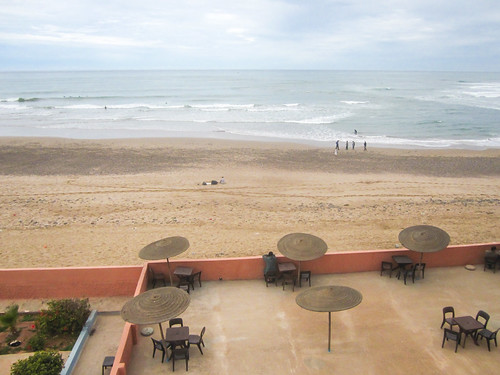
The road from Sidi Ifni to Guelmim is rather eventless, there is only one little village in between and one hill up to 600 m.
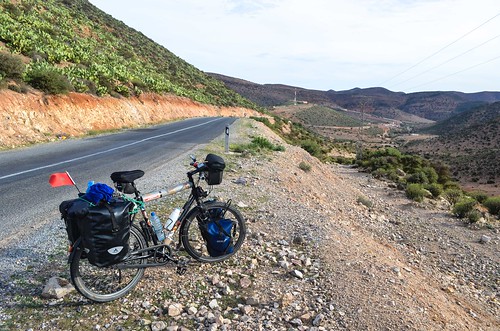
However, before reaching Guelmin, there is a small place called Abaynou, 10 km off the main road, which has a thermal pool. I decide to spend the night there instead. I am looking to get a room as the weather forecast lets me understand I’d probably wake up under the rain, and am quickly re-routed from the 300 dh hotel to the spare room at the café of Mohammed at 60 dh. There is always a double standard for accommodation, the relatively expensive one for tourists and camper vans, and the small hotels (where a room costs no more than a ticket for the campground in the places catering foreign tourism). A chat with the locals comforts my choice as they expect tornadoes with wind up to 100 km/h and the first rain of the year. So I can soak happily in the empty pool, hoping that it will contribute to restoring some muscle power. My legs are not fresh despite their two days of resting and eating seafood in Sidi Ifni.
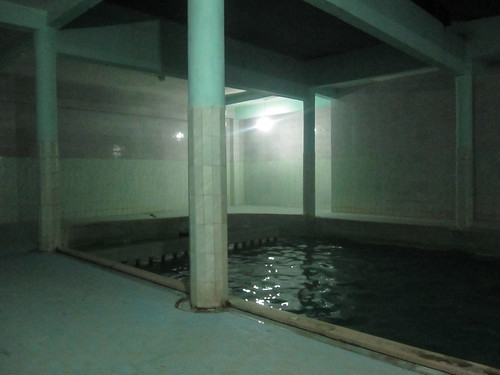
I wake up with the loud wind and rain outside. I am glad I chose not to camp, but am annoyed that I can’t take the road. The wind is coming from the south and is strong enough to make the walk against it painful, so cycling against it would drain all my energy with just a very few kilometers. That makes one extra rest day for my legs, but the bad news is that the rain (and the south wind, the greatest factor of demotivation) will continue for 1 or 2 more days.
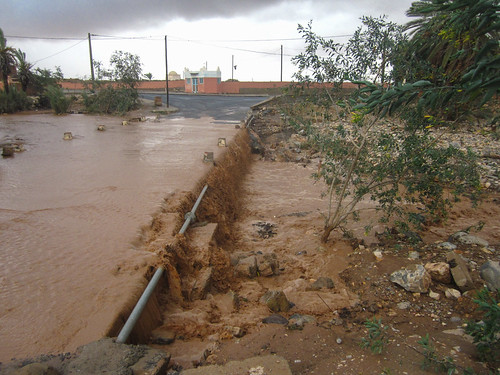
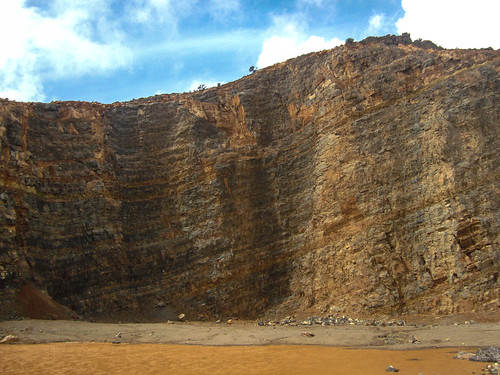
The next morning in Abaynou starts as expected: cloudy and windy. It rained at night, outside and, thanks to the porous roof, a bit inside too. I have to complete 100 km per day to be within my visa dates so I have no choice but to take the road.
The 15 km until Guelmim pass well. The wind is strong and just against me, so I feel good maintaining a speed just over 10 km/h. It’s frustratingly slow but it’s more than what I would do with yesterday’s wind. It is half of what I would do without wind and three time less than with a tailwind, but here also no point discussing the Acts of God.
Guelmim is the “gate to the Sahara” because from here starts the unique road until the bottom of Morocco (incl. Western Sahara) and huge distances between cities. There is actually another road more inland but it’s sometimes on Algerian territory and is mined anyway, and probably reserved for the Moroccan army.
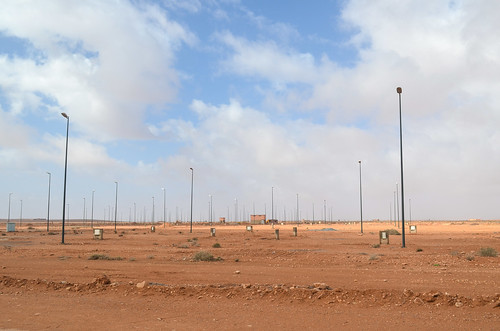
In Guelmim, many people gather around the central oued, probably dry most of the year, and today a strong red water river.
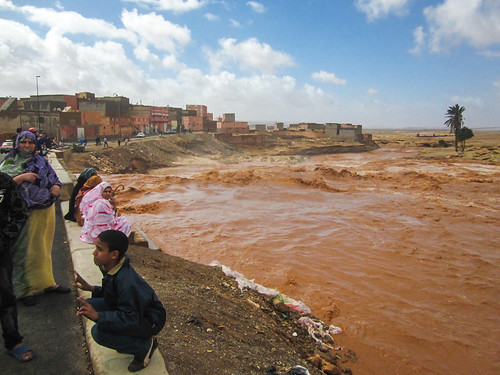
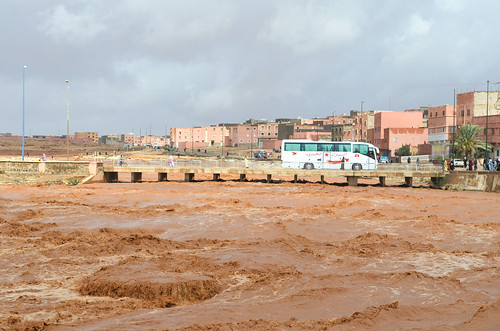
At the last petrol station next to the future edification of a concrete “gate” over the road, I pack 3 more liters of water, bread for the day, and it’s time to disconnect the brain and to go into the wind. Until now, I survived very well with 1.5 liter capacity on the bike frame. I was refilling anytime in the villages and barely had to use my emergency 1L bottle in the pannier. I drank water from any tap or any bucket in any big or small town and never got sick. The tap water had never been yellow or dirty. Had I followed the “official recommendations for tourists” to drink only bottled water in Morocco, I’d have increased my food budget by 50% for nothing.

The next town is Tan-Tan, 120 km away. Impossible to reach today but I will go as far as I can. The water floods most of the fields around the road. There are many green fields that I didn’t expect here and it looks less desertic than the road above 1500 m that I’ve taken in and around the Atlas. There are many plantations of cactus figs as well.
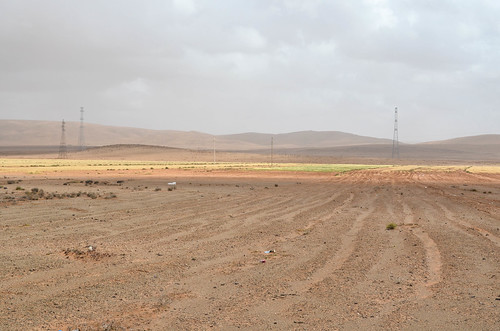

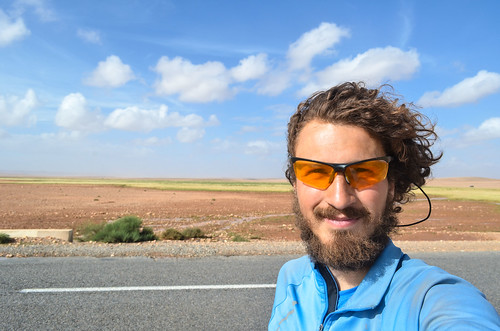
The wind from the south will be against me anyway and I can only hope for it to change direction because my road is straight south-southwest. When there is a bit of sand among the fields of rocks, I can see it flying over the road and it doesn’t take long to get it all over my face (and hair and bike and ears …). There are a few raindrops from time to time. The road has quite a good traffic, half of the vehicles being trucks, I must always be vigilant. I hear nothing coming from the back because of the wind so I must keep an eye on my rear mirror at all times. Usually they overtake correctly, but when they cross another vehicle, there is no space for the 3 of us on the 2-lane road so I am the one designated by the law of the road jungle to jump in the roadside.
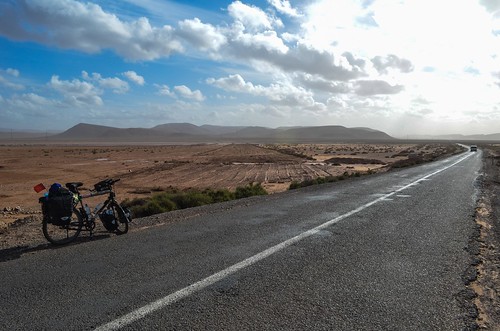
Until now it sounds like all the bad conditions put together to go cycling. I have the excitement of thinking that I’m cycling in the Sahara, this only helps for the mental strength, but does nothing against my back that starts aching already. My rested legs will not last long either.
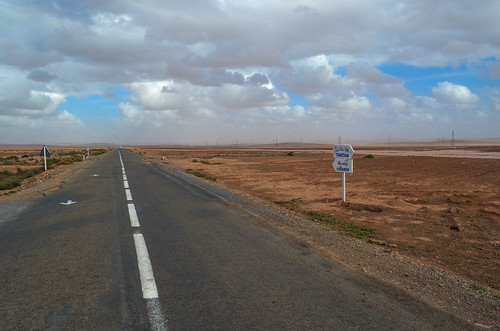
Yet I get to chat at a roadside café at KM 20 after Guelmim, where no one stops. Also shortly with nomads with goats. Apparently, between Guelmim and Tan-Tan, there is a village, 25 km away, or 35 km away as I am told 10 km further. Indications containing kilometers by people who just know the greetings in French are as reliable as a weather forecast.
After only 70 km of pain, I reach another roadside café where I stay for the night. Only 4 people live in those 2 buildings so the high voltage electricity line across the road do not connect to the houses. I can speak Spanish again and I guess it won’t be the last time. First because Western Sahara was under Spanish control until 1975, then because the Canaries islands, less than an hour flight away, were hiring a lot of Moroccan workforce until the recent years. Now even Moroccans with the right papers don’t work there, the lack of jobs and high prices for food and rooms making the experience more painful than staying in Morocco. Still, I found 2 persons who have recently tried to reach the Canaries (in Lanzarote or Fuerteventura) on an overloaded small boat. The punishment for leading a clandestine immigration trip is 6.5 years of jail.
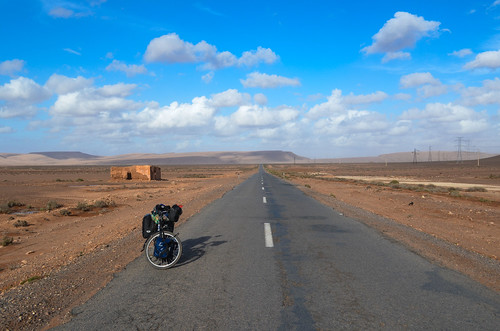
The wind from the coast is still strong in the evening and will bring clouds and rain during the night, so I am glad I am not camping. On the positive side, I get to cook my spaghetti in a real pot instead of my portable one, so I don’t need to cut them in three to fit. And I still have the Maroc Telecom 2G internet … with an average ping of 4500 ms (it can be much worse), just good to receive emails.

The next day seems a bit better, wind-wise. Until the village of Rass Oumlil, I am using my Rohloff gears 5 to 7 (out of 14) instead of 4 to 6 yesterday. Those are still gears for mountains … as the wind is still strong and right against me.
The road smells sometimes like a cemetery of dead wet dogs is hidden under the stones. But, seeing nothing, I never figured out why. There are sometimes dead animals by the road but they don’t smell as much.

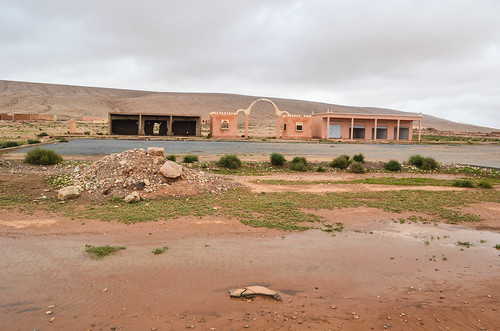
Rass Oumlil has 4 or 5 restaurants and shops, so it makes a useful stop right in between Guelmim and Tan-Tan. The air is wet, the rain of the night has helped making the sand thicker so it doesn’t fly as much into me.
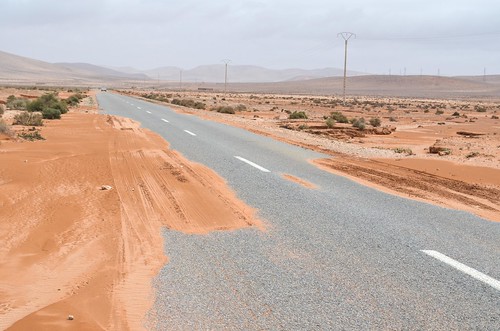
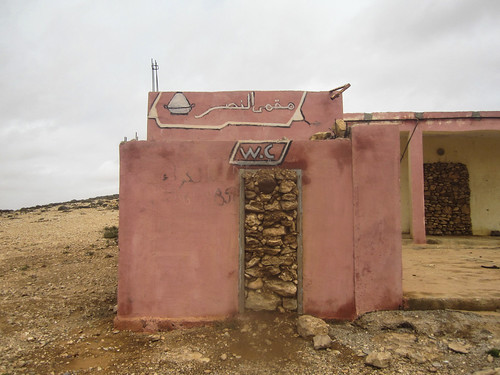
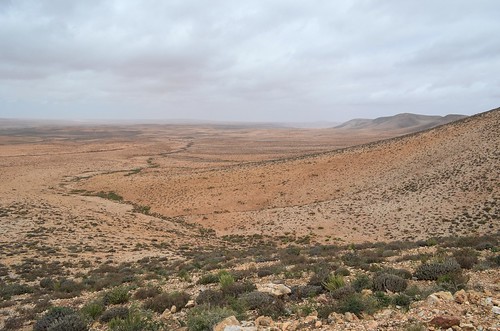
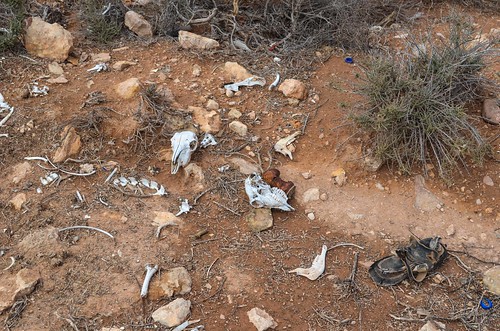
Not far from those bones, I meet Franklin, my host in Ifrane, 1500 km earlier, on his way to Laayoune. Since there is now only one road to go south, it’s impossible to miss me.
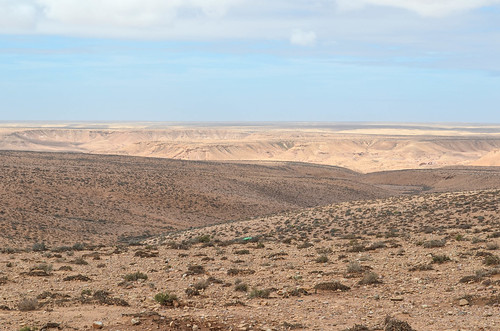
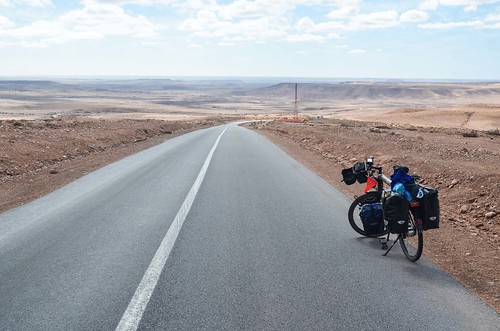

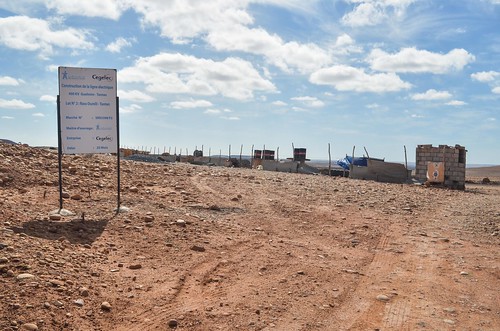
The Oued Draa, the longest river of Morocco with 1100 km, is here again. I had followed it near Agdz and this is here, in the desert, that it ends its route.
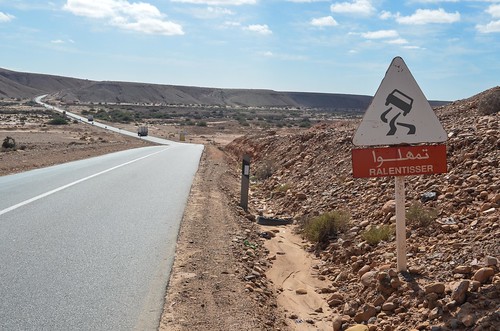

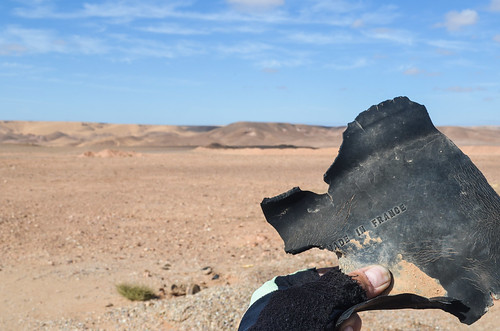

I reach Tan-Tan after 60 kilometers of nothing. Despite having much more, I have tried to survive those 60 km with only 1.5 L of water since Rass Oumlil. I managed to do it, but the 1 L Sprite bottle bought in Tan-Tan lasted only 2 minutes. The people of Tan-Tan are rather White while I expected to see darker skins in the desert.
For the first time, the police/gendarmerie checkpoint at the entrance of the town is stopping me. Usually, they let me go through without any question. They probably stopped only Moroccans to get a few dirhams on the top of their already relatively comfortable salary. But this time, the target Moroccans/Foreigners is inverted: I am asked my passport to get my details recorded for security purposes. I knew this would happen in Western Sahara, but not already in Tan-Tan, which is 250 km before the disputed border.

It is 18:00 when I decide to push it further to keep up with my 100 km / day objective. I have 25 km to do until El Ouatia, called Tan-Tan plage, by the coast. It is getting night, I am very tired but the mental pressure to get to this place before night helps me to maintain an average between 20 and 30 km/h, which is a good speed on a fully loaded bicycle and the wind not helping. It is not so much against me as in the afternoon, but it drained my legs energy already anyway.
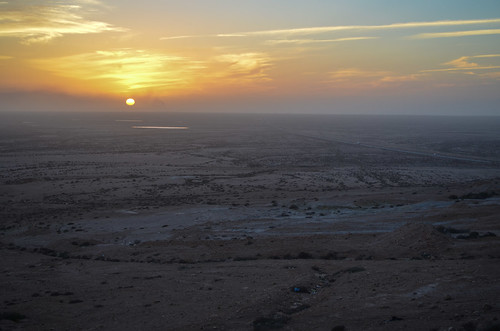
I get to El Ouatia after cycling the very last kilometers by night, which is very uncomfortable. I head straight to the end of the road, which leads me to the port and grants me an extra 2 km to cycle backwards. El Ouatia is a popular place for tourists in camper vans, but I find the cheap hotel, where the reception boy proudly introduces himself as Sahrawi, and finally rest.
The town of El Ouatia has a strange feeling, lit partly with low energy yellow bulbs. While having dinner, I notice that the evening mosque call unusually draws most of the population of the cafés out, while it’s a sacred Champion’s League evening. Maybe because it’s PSG playing and not Barcelona …

At the Pisserie, I find a tablet of Milka+Oreo chocolate, a miracle that spares me from eating the infamous Maruja chocolate. I am very tired but must go again for some windfighting tomorrow.
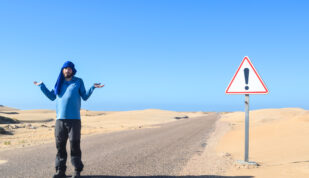
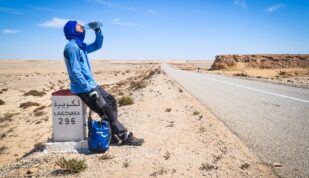
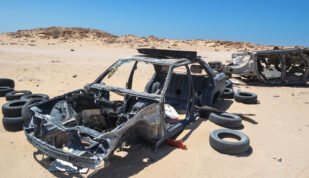


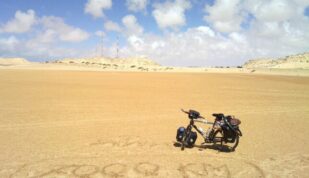
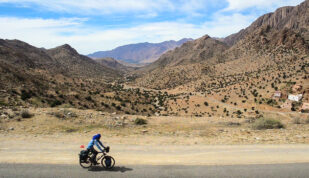
there is actually 3 road lead to Mauritania
– N1 pass LAAYOUN and EDDAKHLA to GERGARAT
– N3 pass LAAYOUN, EDDAKHLA, AOUSSERD, AGOUNIT to the Mauritanians border ( citie of choum)
– N5 pass LAAYOUN, GUELTAT ZEMOUR, MIJEK to the noth of ZOUIRAT in Mauritania
there is also the N14 pass LAAYOUN, ESSMARA, AHL MAHBAS to TINDOUF in south west of ALGERIA
BUT all this road can not thake you out of Morocco because of the western sarahara conflit